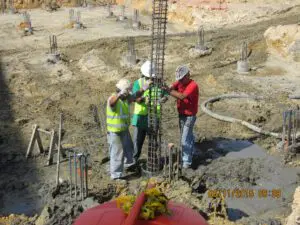What Are Auger Cast Piles
American Deep Foundations (ADF) is a trusted source for the installation of auger cast piles. Auger cast piles may also be referred to by many names, such as auger cast in place piles, auger piles, augered piles, augered cast in place piles, continuous flight auger piles, CFA piles or auger pressure grouted piles.
How are auger cast concrete piles installed?
American Deep Foundation, Inc. installs auger cast in place concrete piles by rotating a hollow stem steel auger into the ground either to a length that allows the friction between the pile and the soil to carry the required load, to refusal on or into a hard layer of dense material that will carry the load in end bearing or to a depth that allows the pile to carry the load in a combination of friction and end bearing. Once the auger reaches the required depth, fluid concrete grout is pumped through the auger under pressure in sufficient volume to maintain a head of grout above the tip of the auger. This head pressure keeps the walls of the augered hole from collapsing and penetrates into softer layer to increase the capacity of the pile. After the auger is withdrawn and before the grout has begun to set, steel reinforcing is placed in the pile through the fluid grout. Typically, a rebar cage is installed to handle lateral loads and/or a single bar in the center is installed for tension loads.
Are auger cast piles less expensive than driven piles?
Many factors play into the cost of a pile installation. Cost of material, cost of equipment and personnel mobilization, soil conditions, the length of the piles and the quantity and spacing of the piles all affect the economy of installing cast in place piles. Augered cast in place piles can be very economical under the right conditions.
Augercast piles typically cannot be installed closer than six pile diameters until the grout in the adjacent pile has achieved its initial set without approval of the geotechnical engineer. Because of this, to demonstrate the worst case, a project with only four piles may take four days to complete. In addition, this limitation requires a good deal of the jobsite to be available to the pile contractor so that he is able to install one or more piles in different caps per day taking several days to complete one cap. If there aren’t enough piles or if access to piles will be blocked by installing additional piles, the process may become inefficient. Driven piles, however, can typically be installed adjacent to each other immediately allowing each cap to be completed prior to moving to the next cap. This allows a continuous operation and allows the following trades access to the initial caps sooner.
 Auger cast pile grout is readily available locally and is inexpensive when compared to steel piles. Reinforcing in auger piles varies depending on load and the design engineer. Reinforcing steel cages can be tied or welded on or off the job site prior to being installed. The amount and length of pile reinforcing can greatly affect the cost of the pile installation both in material cost and the difficulty of installation.
Auger cast pile grout is readily available locally and is inexpensive when compared to steel piles. Reinforcing in auger piles varies depending on load and the design engineer. Reinforcing steel cages can be tied or welded on or off the job site prior to being installed. The amount and length of pile reinforcing can greatly affect the cost of the pile installation both in material cost and the difficulty of installation.
The amount of grout required to make auger cast piles and the risk of who pays for excess grout takes depends on the project’s geotechnical profile. In profiles with several N values below three, in areas prone to vary greatly in the amount of grout necessary to make a quality pile and in areas prone to sink holes, it is typical for the pile contractor to limit the amount of grout that is included in his base bid; for example, the pile contractor may in include an amount of grout equal to theoretical volume plus 25% overtake. When the auger cast pile contractor limits the grout, he is paid a unit price per cubic foot for pile grout in excess of that included.
The crew required to install auger cast piles is usually larger than the crew required to install driven piles. A typical auger cast crew will consist of a superintendent (to manage the overall pile portion of the project), a driller/foreman (to manage the pile rig and assure that quality piles are being installed), an experienced certified crane operator, a grout pump operator and three or four experienced pile drivers and laborers.
What size and length augered cast in place piles are typically installed?
Auger cast piles typically have a diameter of 12 inches to 36 inches; however, diameters up to 48 inches have been installed. Auger cast piles are commonly installed up to approximately 100 feet, but much longer piles have been installed.
What are some advantages of auger cast piles?
High Friction Capacity – Because of the pressure and the weight of the pile grout, the pile forces itself into soft zones in the soil profile. That combined with the uneven surface of the augered hole creates a very good friction bond between the pile and the soil. In many geotechnical conditions auger cast piles will carry significantly higher loads in friction than other types of piles.
Flexible to Variation in Lengths – In varying subsoil conditions pile lengths can vary drastically. Auger cast piles often are installed using multiple criteria to determine where to stop the tip of the pile. By calculation, usually confirmed by load test, the engineer can determine that a pile of a specified length is sufficient to carry the design load plus necessary safety factors in friction. However, there may be layers of material that will prevent the pile from reaching this length but that may be capable of carrying the load in end bearing or a combination of friction and end bearing. A typical pile installation criteria would be to state a maximum pile length or maximum pile tip elevation but then include a refusal criteria if encountered above the maximum length. The industry standard refusal criteria is one foot of penetration or less in one minute using the specified drilling equipment.
Less Noise – Since augered piles are drilled, not driven, into the ground hey cause less noise than driven piles.
Minimum Vibration – With no hammer impact, auger cast piles can be used close to vibration sensitive buildings, equipment and foundations.
How do you test the capacity of auger cast piles?
Since there is no hammer blow count with which to gage the capacity of an augered pile, a static load test is normally used to verify capacity. Normally a few typical piles are installed across the site to function as probe piles to determine if the drilling conditions are consistent or if there is a range of conditions. These probes can be augered and not grouted, augered and grouted in permanent pile locations or augered, grouted, and abandoned. Using the information gained from drilling the probe piles, the geotechnical engineer will select a location or possibly multiple locations to install test piles. In some cases, one of the probe piles will be used as a test pile.
The test pile is normally tested in accordance with ASTM D1143. The “quick test” is most common.

Which auger cast pile contractor should I use?
Since auger cast in place grouted piles can not be inspected after they are installed, it is critical that the installer of the piles be reputable and experienced. Installing auger cast piles in Wilmington, North Carolina is very different than installing auger cast in Atlanta, Georgia or Orlando, Florida. You must be sure that the pile contractor that you hire has extensive experience installing similar diameter, length and capacity piles in similar soil conditions near the location of your project. American Deep Foundation, Inc. has experience with all types of piles throughout the southeast and the east coast.

